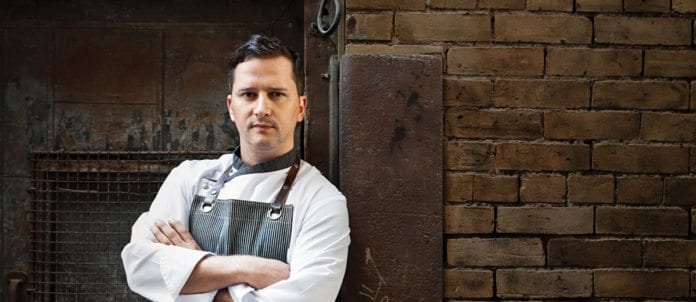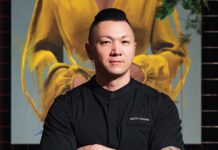Toronto is strengthening its reputation for fine seafood, thanks to chefs like Michael Steh. Growing up in Oshawa, Ont., the young chef started cooking at Slovenian banquet halls with his mom and canning his own fruit and vegetables at home. But, since moving to Toronto, and graduating from George Brown College, the chef has helmed the kitchens of some of the city’s most celebrated restaurants, including Canoe and Splendido, and recently, SIR Corp.’s Reds Wine Tavern. For the past year, the 36-year-old has been the executive chef at a growing network of seafood restaurants by Toronto’s Chase Hospitality Group, including The Chase, The Chase Fish & Oyster and the soon-to-open Little Fin. He’s setting higher seafood standards while respecting his ingredients.
F&H: What’s your missionat The Chase?
Michael Steh: Providing the healthiest and most vibrant opportunity for seafood in the city. We sell over 30,000 oysters a month between The Chase and Chase Fish and Oyster. This gives us the ability to always keep it fresh and use the best product available.
F&H: How do you source seafood?
MS: We make responsible choices. We make ourselves very aware of what is on the lists of ‘not-to-use’ items. More times than not, it’s the way an item is fished rather than the fish species that makes it one we shouldn’t use, so we try to use as much of a direct-to-source approach as possible. Going directly to growers, producers and fishermen gives you the ability to understand how they do what they do and why.
F&H: How are you adapting to an increasingly health-conscious clientele?
MS: [Serving] rich, high-sodium foods is not what we do with every dish, but those elements are present when they need to be. We try to provide a balanced menu that allows our guests to be given options and create their own…. We prepare dishes with as much raw applications as possible, using fresh citrus as opposed to vinegars, whole grains, cultured dairy and a philosophy to “use just enough” in the food we prepare.
F&H: What constitutes a good dish?
MS: A “good” dish is balanced, not only in flavour but in texture, size and with a good hint of addictiveness. One of our best is the Avocado Roll stuffed with shrimp and fresh mango ($20). F&H: Which ingredients are you excited to use in the summer months? MS: Tomatoes, corn, wild salmon, soft-shell crab, strawberries and fresh fruit from Ontario, spot prawns, fresh-cut greens — the list could go on. There is nothing better than using a product so fresh it’s still warm from the sun and perfectly ripe and ready to serve.
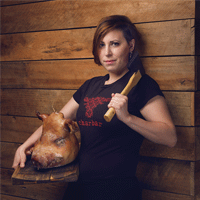 Native Calgarian Jessica Pelland has been busy making a name for herself in the restaurant industry (and outside of it). The mother-of-two, and event chef at Calgary’s award-winning Charcut Roast House, earned the top spot in an episode of the inaugural season of the Food Network’s Chopped Canada competition earlier this year. And, with training at Calgary’s SAIT Polytechnic, and a decade of experience in Calgary at places such as the MacEwan Conference & Event Centre and the Redwater Rustic Grille behind her, the 28-year-old who specializes in whole-animal butchery, is poised for her next undertaking — assuming the role of executive chef at Charbar. The new venture, from the folks at Charcut, is set to open next spring.
Native Calgarian Jessica Pelland has been busy making a name for herself in the restaurant industry (and outside of it). The mother-of-two, and event chef at Calgary’s award-winning Charcut Roast House, earned the top spot in an episode of the inaugural season of the Food Network’s Chopped Canada competition earlier this year. And, with training at Calgary’s SAIT Polytechnic, and a decade of experience in Calgary at places such as the MacEwan Conference & Event Centre and the Redwater Rustic Grille behind her, the 28-year-old who specializes in whole-animal butchery, is poised for her next undertaking — assuming the role of executive chef at Charbar. The new venture, from the folks at Charcut, is set to open next spring.
F&H: What’s your earliest food memory?
Jessica Pelland: I remember that I didn’t like green beans. To change my mind, my mother would tell me that everything I ate was green beans. It worked. F&H: How did you get into foodservice?
JP: I’ve always been in the kitchen. My mom has a photo of me helping her make my first birthday cake, though I was making more of a mess than anything. Our family revolves around the kitchen. I have a late uncle who owned a restaurant in San Francisco and cousins who are also chefs. It runs in the genes.
F&H: How have you evolved at Charcut?
JP: I started at Charcut when they opened in 2010 as the lunch, soup and fry girl. I worked my butt off and made my way up through the ranks. I reached a peak last year and also had a baby, so I was off. But then [Charcut co-owners] John [Jackson] and Connie [DeSousa] approached me about this new project, and they were like, ‘This is perfect timing, because when you return, you’ll have a year-and-a-half to get into things.’”
F&H: Tell me about Charbar.
JP: Charbar is located on the Bow River, so we’re going to take inspiration from the river. It’ll still be pretty meat-heavy [like Charcut], but on the lighter side with the introduction of more seafood. It’s going to be designed to be inviting to all, but on the higher end…. We’re partnering with Phil & Sebastian Coffee Roasters and [local artisan bakery] Sidewalk Citizen Bakery. We’re going to be selling their coffee and bread in the restaurant. When you walk into the building, it’ll be open with a market feel. You’ll see the coffee roaster and a full-production bakery on premises. I’m terrified but extremely excited. And being a bit afraid is a good thing; I want to do a good job.
F&H: What did the Chopped Canada win mean to you?
JP: The biggest thing is my family — for them to see and be proud of me, because … I sometimes have to miss important dinners and occasions for work, but my family is always super supportive of me. I did it for them. I would love for Chopped Canada to call me back and ask me to do a “Chopped-champion” [episode]. I would do it in a heartbeat.
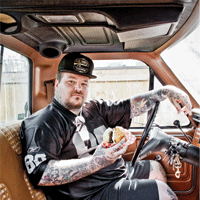 As executive chef at Parts & Labour and a part owner of P&L Burger, Matty Matheson is a young Toronto cook on the rise. The 32-year-old’s ascent began in earnest when he launched quirky dining, drinking and retail establishment Oddfellows in 2008 before joining the opening team at Parts & Labour (P&L) in 2010. Since then P&L, a funky Parkdale neighbourhood restaurant, bar and music venue, has earned a Best-Burger-in-the-city distinction from the CMT TV network’s Burger Wars, giving its eight-month-old sister restaurant, P&L Burger special cachet. In 2011, the Humber grad became a founding member of the Group of Seven Chefs, a collaborative organized by Beast Restaurant’s Scott Vivian to draw attention to the Toronto culinary scene. Since then, he’s continued to contribute to a network of other projects.
As executive chef at Parts & Labour and a part owner of P&L Burger, Matty Matheson is a young Toronto cook on the rise. The 32-year-old’s ascent began in earnest when he launched quirky dining, drinking and retail establishment Oddfellows in 2008 before joining the opening team at Parts & Labour (P&L) in 2010. Since then P&L, a funky Parkdale neighbourhood restaurant, bar and music venue, has earned a Best-Burger-in-the-city distinction from the CMT TV network’s Burger Wars, giving its eight-month-old sister restaurant, P&L Burger special cachet. In 2011, the Humber grad became a founding member of the Group of Seven Chefs, a collaborative organized by Beast Restaurant’s Scott Vivian to draw attention to the Toronto culinary scene. Since then, he’s continued to contribute to a network of other projects.
F&H: Why did you pick a career in food?
Matty Matheson: I got accepted to just one college and that was Humber for cooking. I thought it would be fun to study, but I didn’t imagine I was going to be a chef. I didn’t even know what line cooking was. I was from Fort Erie, [Ont.], a small town with only chicken wings.
F&H: What appealed to you about cooking?
MM: I love the intensity of kitchens. I love being part of a closely knit team. Most jobs aren’t like that — where you spend 12 hours next to someone. It’s really an extraordinary thing, like being in a submarine. F&H: What’s your food philosophy? MM: Cook simply — make food taste like you wish your mother’s did.
F&H: What is your trademark dish?
MM: The P&L burger. *Editor’s Note: The original P&L burger is seven ounces of Canadian brisket topped with dill-mayo, bacon-onion jam, lettuce and Monterey Jack cheese on a toasted milk bun and served with fresh-cut fries ($15)
F&H: Tell me about the Group of Seven.
MM: We’re a group of friends who wanted to cook some fun meals together on our days off. For a couple of years, we put on special dinners on the last Monday of every month. Now we’ve slowed down and only do two or three events a year at different restaurants, [Toronto’s] Evergreen Brickworks, art galleries and so on. Working next to chefs is always inspiring; seeing what they’re doing, seeing how they handle themselves, learning different techniques. You watch somebody do something amazing, and it inspires you; it makes you want to kill it.
F&H: What excites you about your job?
MM: What’s next. Working on and tightening up what we have; building another thing. Now [our ownership group] has Parts & Labour, Dog & Bear [a sports bar/pub], P&L Burger and a catering company that we just got a new space for. I love the setup and the stuff that goes on behind building something new. It’s fun to start with an empty space, and then all of a sudden it’s a fully functioning production kitchen.
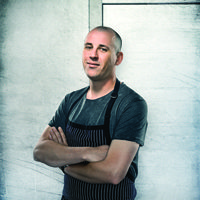 David Battcock is making a change. In the past dozen years, the chef travelled from his native St. John’s, N.L. to work in fine-dining establishments in Toronto and the Cayman Islands before answering “a call for home” in 2012 and taking the executive chef job at Atlantica Restaurant. In December, he left Atlantica to embark on a new journey, and now he’s preparing to open a butcher shop and, eventually, a restaurant to go with it. Both will focus on products from local farmers and purveyors. Scheduled to open in mid-summer in St. John’s, the provisionally named Meat Locker will be a 3,000-sq.-ft. homage to meat with two walk-in fridges and dedicated spaces
David Battcock is making a change. In the past dozen years, the chef travelled from his native St. John’s, N.L. to work in fine-dining establishments in Toronto and the Cayman Islands before answering “a call for home” in 2012 and taking the executive chef job at Atlantica Restaurant. In December, he left Atlantica to embark on a new journey, and now he’s preparing to open a butcher shop and, eventually, a restaurant to go with it. Both will focus on products from local farmers and purveyors. Scheduled to open in mid-summer in St. John’s, the provisionally named Meat Locker will be a 3,000-sq.-ft. homage to meat with two walk-in fridges and dedicated spaces
for charcuterie, smoked meat, and “anything-I-can-get-my-hands-on”game, including moose and rabbit.
F&H: What role did food play in your childhood?
David Battcock: We always thrived on good food and weren’t into processed ingredients. Mom did a lot of baking, stews and traditional Newfoundland dishes, like Jig’s Dinner — beef, cabbage, carrot and onion in a pot. And we ate a lot of seafood — scallops and salt cod.
F&H: Why a butcher shop?
DB: I spent 12 years of blood, sweat and tears in the kitchen and always [suffered] because we were lacking suppliers. I’m going to take it on myself to become one of those suppliers. And I’m trying to keep it as local as possible to help my community. There’s only one butcher shop in the city now — it’s 100 years old, and [the owners] haven’t done anything different in 100 years. I’m looking to give a better perspective on food. So many people have lost touch with where their food comes from.
F&H: Do Newfoundlanders like meat?
DB: Absolutely. But, right now, the farming industry here isn’t the greatest. There are only 35 or 40 cattle per farm and only two pork producers on the island. I have a plan to open a farm and a slaughterhouse down the road from the butcher [shop], because I’m having trouble sourcing certain ingredients. Up to 80 per cent of our fish is exported, so it’s not as easy as you would think to get fish, either.
F&H: Tell me about the restaurant.
DB: I’m going to open a southern barbecue restaurant. It’s my favourite food: ribs and brisket, anything slow-cooked.
F&H: Why is it important that we know food’s provenance?
DB: It gives the food more meaning, as opposed to just filling a void in your stomach. Food gives us life. A couple of years into being a chef, I saw all this animal product coming across my board and realized I didn’t know the story behind it. I’ve made an effort to change that. Now I’ve slaughtered, I’ve farmed, I’ve tried everything to make sure I know exactly where food comesfrom — to give it respect.
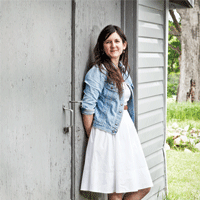 Miriam Streiman always knew she loved feeding people, but little did she dream she’d end up running Mad Maple, a quaint inn in Creemore, Ont. where she satiates her guests’ desire for good food and serves as a conduit for them to experience the wonders of nature, too. Originally, her passion for food led her to Toronto’s George Brown College (GBC) where she graduated from the Culinary Management Program. “I was fortunate to intern at the Food Network, which unexpectedly led to work in food and television with the incredible Claudia Bianchi,” says the 33-year-old. Subsequently, she enrolled in GBC’s Italian Culinary Arts Program where Paul DeCampo’s Slow Food course played a pivotal role in her approach to food. Eventually, she found her calling at Mad Maple, which she opened in 2012.
Miriam Streiman always knew she loved feeding people, but little did she dream she’d end up running Mad Maple, a quaint inn in Creemore, Ont. where she satiates her guests’ desire for good food and serves as a conduit for them to experience the wonders of nature, too. Originally, her passion for food led her to Toronto’s George Brown College (GBC) where she graduated from the Culinary Management Program. “I was fortunate to intern at the Food Network, which unexpectedly led to work in food and television with the incredible Claudia Bianchi,” says the 33-year-old. Subsequently, she enrolled in GBC’s Italian Culinary Arts Program where Paul DeCampo’s Slow Food course played a pivotal role in her approach to food. Eventually, she found her calling at Mad Maple, which she opened in 2012.
F&H: What is your mandate at Mad Maple?
Miriam Streiman: We want to create experiences that are generous, authentic and hand-crafted. Mad Maple is a hub for food, arts and culture and a forum for collaboration. We offer accommodations, present events, private dinners, cooking workshops and work with other chefs, artists, farmers, foragers and authors. As an inn, we are ambassadors for our community. I want to create a destination and a brand that tells a story through food and our landscape.
F&H: Tell me about the food you prepare at the inn?
MS: The food is made from scratch and with heart and is dictated by the rhythms of the seasons. We work closely with producers and artisans in our area and beyond. The food producers and those relationships are the foundation of our food programming. F&H: Where do your source your ingredients? MS: Brent and Gil at the New Farm, Hugh Simpson from Osprey Honey Bluffs, Roy and Ginny at Roy’L Acres, Kit and Mary Anne Tupling, Sheldon Creek Dairy, K2 Milling, Monforte Dairy and more.
F&H: What are some of the most popular dishes you’ve created at the inn?
MS: Among our popular creations are Red Fife Maple Scones, Duck Egg Pasta, Foraged Edibles cooked over fire with Runny Poached Eggs, Marzipan Almond Tarts with Caramel Apple Butter and Soma Chocolate Chip Cookies.
F&H: What are your favourite food memories?
MS: Along with my husband, Neil, making roast chicken in the wood oven; sipping warm ricotta from the ladle in Italy and sitting at huge family tables with my grandparents.
F&H: How is the evolving food movement affecting what you do at the inn?
MS: It’s about authentic experiences told through food, something people are interested in now as part of social gathering. It’s also a vehicle to bring people together. At Mad Maple guests will often not know one another, but by sharing a table or preparing recipes together in a cooking class, people are connecting and engaging with their food.














